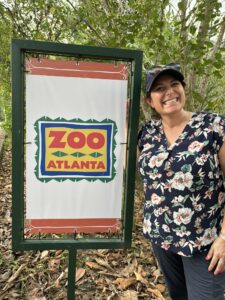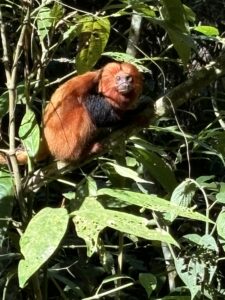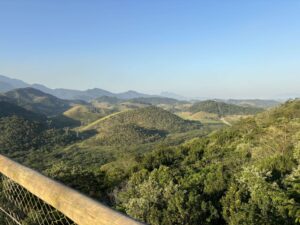Saving the golden lion tamarin
Earlier this month, you heard stories about the amazing work one of our Zoo Atlanta signature conservation partners, Associação Mico-Leão-Dourado (AMLD), or Golden Lion Tamarin Association (GLTA) and the work they do in Brazil to recover the small, beautiful, orange monkeys that make the Atlantic Coastal Forest their home – the golden lion tamarin. At Zoo Atlanta, our conservation strategy supports different aspects of in situ work, and one of our goals is to support organizations by connecting Zoo Atlanta staff expertise with our partners. In 2024, our Zoo Atlanta Vice President of Education, Staci Wiech, and Vice President of Animal Collections and Conservation, Dr. Gina Ferrie, had the opportunity to support our partner AMLD by visiting their home base in Brazil. While Staci and Gina both visited the same locations and sites, the goals of their visit were very different, and both had truly incredible but different experiences, focused on contributing to varying aspects of in situ conservation through their expertise. Here are their stories:
 Gina:
Gina:
Zoo Atlanta has been participating in golden lion tamarin conservation for more than 30 years. This species was one of the first global reintroduction success stories, and two family groups of tamarins from Zoo Atlanta made the journey to Brazil to be released into protected forests in the 1990s. The populations of tamarins in Brazil are recovering, due to the efforts of AMLD and other stakeholders, but threats remain. With my scientific background and expertise in population genetics, population modeling, and in situ and ex situ population management (meaning those populations in the wild and in zoos), I was invited by our colleagues to participate in a three-day workshop organized and facilitated by the Brazilian government, to contribute to the development of the next Global Population Management Plan for golden-lion tamarins.
The meetings were intense, with hundreds of years of experience in golden lion tamarin conservation present in the room, including academic researchers, field biologists, government officials, and law enforcement. The meetings were conducted in Portuguese (Brazil’s national language), and while I do not speak Portuguese, I was able to understand, communicate, and contribute with my basic comprehension of Spanish, Google Translate, and some patient colleagues. This was tiring and my brain worked hard, but how rewarding to be a part of such a passionate group of people literally writing the plan to ensure golden lion tamarins are around for a long time to come. It made the evenings of family-style, social dinners, with tasty Brazilian cheese bread and maybe a glass of cachaça (Brazilian sugarcane liquor) or a Caipirinha even more enjoyable after long days of tough, rigorous work and planning.
After these meetings, the work was not yet done! Save the Golden Lion Tamarin (SGLT), the U.S.-based nonprofit organization that supports AMLD, has attributed part of its success to the thoughtful and strategic process they regularly undertake. This conservation planning is done by combining population targets and goals (developed through a scientific method called population viability analysis) and using the Open Standards for the Practice of Conservation, a globally adopted set of principles to help conservation programs ensure they are making an impact in all aspects of conserving a species. This meeting was focused much more on how the global ex situ (or zoo) population would be managed in the future to support the Brazilian populations, as well as what actions AMLD and SGLT would be doing in the coming years.
 If all this sounds like a lot of meeting time, I will agree, it was! But for me, doing this scientific planning and evaluation of goals is some of the most important and rewarding parts of conservation, so we know where we are succeeding, or need to change strategies. Yes, a lot of conservation is not always glamorous, or done outside, in nature, but it’s working collaboratively with people, policymakers, scientists, and building informed consensus on how to save a species.
If all this sounds like a lot of meeting time, I will agree, it was! But for me, doing this scientific planning and evaluation of goals is some of the most important and rewarding parts of conservation, so we know where we are succeeding, or need to change strategies. Yes, a lot of conservation is not always glamorous, or done outside, in nature, but it’s working collaboratively with people, policymakers, scientists, and building informed consensus on how to save a species.
Don’t worry though, this trip wasn’t all work and sitting inside in meetings. I did have the opportunity to wake up each morning, go for a walk or hike in the forest, and on one very special morning, spend a few hours surrounded by two large families of golden lion tamarins. And remember at the beginning I mentioned Zoo Atlanta sent two families of tamarins to Brazil in the late 1990s? These tamarins I spent time with are descendants of those reintroduced golden lion tamarins – Zoo Atlanta literally runs through their blood! Thank you to AMLD, SGLT, Zoo Atlanta and many others for all of your years supporting golden-lion tamarin conservation, and for supporting me to be an integrated part of this program, connecting the expertise of zoos directly to conservation work for threatened species.
Staci:
Following Gina’s visit earlier in the year, I had the opportunity to join a trip that was planned for 2020 but canceled due to the pandemic. AMLD partners with zoos across the country and many zoos, like Zoo Atlanta, have played a key role in the conservation success story of the golden lion tamarin. On this trip, I was joined by six primate animal care staff from Smithsonian’s National Zoo, Philadelphia Zoo, and Greensboro Science Center – all long-term conservation partners of AMLD. Our goal of the week was to immerse ourselves in the work of AMLD to better understand the challenges, the successes, the biodiversity of the region, and the importance of community to their conservation work.
So, in mid-October we all hopped an overnight flight from our respective cities and landed in the bustling airport of Rio de Janeiro to connect for the first time. Met by Laila, the Technical Advisor from AMLD who served as our interpreter and guide for the week, we set off that morning half asleep but so excited for the week ahead. The Atlantic Coastal Forest, where the tamarins are found, is about an hour and half north of Rio in the municipality of Silva Jardim. What was once a complete intact forest hundreds of years ago is now a patchwork of forest and farm field for cattle. As we arrived in the region that morning, you could immediately understand the issue of forest fragmentation that has impacted the tamarin population and the challenge to reconnect and replant forest for the future of the population.
 We stayed in the heart of the region at a farm called Fazenda Dos Cordeiros. What we would come to learn over the course of the week is that AMLD partners with farmers in the region to grow a diversity of native plant species to a healthy stage that they can be successfully planted in restoration areas. Fazenda Dos Cordeiros has been involved with AMLD for several years, and in addition to growing young trees, they have taken other important steps to preserve tamarin habitat, such as replanting and reconnecting forest on their property and embracing agroforestry by planting an array of fruits, vegetables, and other crops within the forest. This practice helps support sustainable land use practices, and AMLD is training other farmers and community members around the region on these practices. This work at the farm has paid off because we saw tamarins using these forests. On early morning walks, we could hear them calling to each other, and we watched as they fed off the fruit of trees. It was incredible!
We stayed in the heart of the region at a farm called Fazenda Dos Cordeiros. What we would come to learn over the course of the week is that AMLD partners with farmers in the region to grow a diversity of native plant species to a healthy stage that they can be successfully planted in restoration areas. Fazenda Dos Cordeiros has been involved with AMLD for several years, and in addition to growing young trees, they have taken other important steps to preserve tamarin habitat, such as replanting and reconnecting forest on their property and embracing agroforestry by planting an array of fruits, vegetables, and other crops within the forest. This practice helps support sustainable land use practices, and AMLD is training other farmers and community members around the region on these practices. This work at the farm has paid off because we saw tamarins using these forests. On early morning walks, we could hear them calling to each other, and we watched as they fed off the fruit of trees. It was incredible!
I can’t think of a better way to truly understand the work of a conservation organization than to work alongside the team and roll up my sleeves to help. And for the week that we were there, we did just that. We traveled around the region with Nelson, the Community Engagement Coordinator, to meet the farmers and helped farmer Marlene prepare soil for seedlings with the guidance of Rubens the Agroecology Assistant. We spent time with Luis Paulo, the Executive Director, and learned about AMLD’s goals, successes, and challenges. We spent time with Carlos and Matteo, Forest Engineers, and visited pristine forest and restored forest. We observed firsthand the diversity of the forest through hikes and bird watching as we were guided by AMLD’s Ecotour Guide, Anderson, and a resident bird expert, Daniel. And a trip would not be complete if we did not see tamarins in the wild. While there, we had the great opportunity to travel into one of the forests with the Monitoring Team, Andrea and Ademilson, to track four different tamarin families. Each group has one individual that wears a radio collar so the team can attempt to find them in the dense forest. On the morning that we arrived we were welcomed by a mother tamarin carrying day-old twins! And our trip was documented by AMLD’s wonderful photographer, Luiz Thiago.
The highlight of the trip for me was planting trees in one of the designated restoration areas, or forest corridors, named for Dr. Jennifer Mickelberg, who passed away in October 2023. Jennifer was the former Vice President of Collections and Conservation at Zoo Atlanta, and she was one of my closest friends. For over 20 years she worked closely with AMLD to help inform decisions on how best to save the golden lion tamarin population. This area of land where we planted was identified by Jennifer as an opportunity for AMLD to reach their goal of having 2,000 golden lion tamarins in nearly 62,000 acres of protected and connected forest. In her honor, it has been named Jennifer’s Corridor. With a full heart and the thought of my friend and conservation hero, we joined the Environmental Education Coordinator, Nandia, and a group of third graders from the local elementary school to plant trees. It was an honor and a privilege to spend time with these young students knowing that they will grow up watching this forest grow and that they had a hand in helping to save species. And it is something that Jennifer would have loved. Her passion for saving wildlife and wild places was contagious, and now her legacy will live on and literally grow in these seedlings that will one day become a connected forest full of tamarins.
Conservation work is hard and time consuming. It involves so many different facets, and every project and program is different. At the heart of conservation work is dedicated and passionate individuals and the AMLD team has some of the largest hearts that I have ever met. Their commitment to golden lion tamarins and restoring forest habitats extends into the communities that they support and youth that will become the next scientists, advocates, and wildlife heroes. I am grateful for my time in the Atlantic Coastal Forest with the AMLD team and came home with a greater appreciation and passion for the important work that they commit to every day. I also came home with new friends in Brazil and hope to one day return and roll up my sleeves again.
To learn more about golden lion tamarins and AMLD’s work and to get involved, please visit https://micoleao.org.br/ and https://zooatlanta.org/project/golden-lion-tamarin/.

Connect With Your Wild Side #onlyzooatl